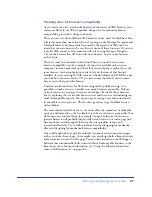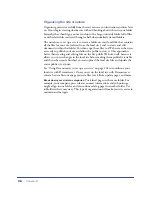
Site Management and Collaboration
111
Always Show
specifies which site (remote or local) is always shown, and in which
Site window pane (left or right) the local and remote files appear. By default, the
local site always appears on the right. Whichever pane is not chosen (the left one
by default) is the changeable pane: this pane can display either the site map or the
files in the other site (the remote site by default).
Dependent Files
displays a prompt for transferring dependent files (such as
images, external style sheets, and other files referenced in the HTML file) that the
browser loads when it loads the HTML file. By default, both Prompt on Get/
Check Out and Prompt on Put/Check In are selected.
Note:
To force the Include Dependent Files prompt to appear even when these options are
deselected, hold down Alt (Windows) or Option (Macintosh) while choosing the Get, Put,
Check In, or Check Out commands.
FTP Connection
determines whether the connection to the remote site is
terminated after the specified number of minutes have passed with no activity.
FTP Time Out
specifies the number of seconds in which Dreamweaver attempts to
make a connection with the remote server. If there is no response after the
specified amount of time, Dreamweaver displays a warning dialog box alerting
you to this fact.
Firewall Host
specifies the address of the proxy server through which you connect
to outside servers if you are behind a firewall. If you are not behind a firewall,
leave this space blank.
Note:
If you are behind a firewall, select the Use Firewall option in the Site Definition dialog
box. See “Associating a remote server with a local site” on page 124.
Firewall Port
specifies the port in your firewall through which you pass to connect
to the remote server. If you connect through a port other than 21 (the default for
FTP), enter the number here.
Put Options: Save Files Before Putting
indicates that unsaved files are saved
automatically before being put onto the remote site.
Define Sites
brings up the Define Sites dialog box, where you can edit an existing site
or create a new one. See “Associating a remote server with a local site” on page 124.
You can also define whether the types of files that you want to transfer should
be transferred as ASCII (text) or binary. To do so, open the FTPExtensionMap.txt
file in the Dreamweaver/Configuration folder (on the Mac, FTPExtensionMapMac.txt).
You can modify and delete the list of which file types are transferred in each
format, as well as add your own file types. If a file’s extension is not defined in this
file, Dreamweaver automatically transfers the file in binary mode.
Note:
On the Macintosh, the FTPExtensionMapMac.txt file also contains information
about mapping file extensions to Macintosh creators and file types. This mapping allows a
downloaded file to be given the correct icon and to be opened by the correct application
when you double-click the file in the Finder.
Summary of Contents for 38028779 - Macromedia Dreamweaver - Mac
Page 1: ...macromedia Using Dreamweaver...
Page 148: ...Chapter 4 148...
Page 296: ...Chapter 12 296...
Page 472: ...Chapter 18 472...
Page 512: ...Chapter 21 512...
Page 562: ...Appendix 562...
















































